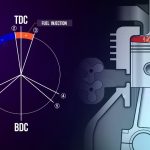2-Stroke Engine cycle in comparison to 4-stroke Engine:
| 2-Stroke Engine | 4-Stroke Engine |
| 2 strokes to complete 1 working cycle | 4 strokes to complete 1 working cycle |
| Air intake through scavenge ports | Air intake through suction valves |
| Low Speed Engines | High Speed Engines |
| Higher power | Lesser power |
| Expensive parts | Cheaper parts |
Advantages of 2-stroke Engines in comparison to 4-stroke engines:
| Two-stroke engines do not have suction valves, hence simple construction. |
| Two-stroke engines have a high power-to-weight ratio (because the engine has twice as many combustions per second as a four stroke engine revolving at the same speed). |
| Two-stroke engines have the potential for about twice the power in the same size because there are twice as many power strokes per revolution. |
| Two-stroke engines are lighter, and cost less to manufacture. |
Disadvantages of 2-Stroke Engines in comparison to 4-stroke engines:
| Two-stroke engines don’t live as long as four-stroke engines as its parts wears out faster due to the lack of a lubrication system. |
| Two-stroke engines require a mix of oil with the gas to lubricate the crankshaft, connecting rod and cylinder walls. |
| Two-stroke oil can be expensive. |
| Two-stroke engines do not use fuel efficiently. |
| Two-stroke engines produce more pollution. |



Comments are closed